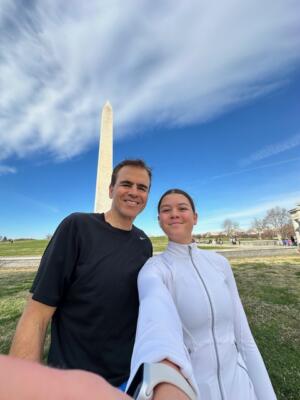#378 Can You Stop Blood Thinners After a Successful Atrial Fibrillation Ablation?
April 5th, 2025 by Dr. John DayCan You Stop Blood Thinners After a Successful AFib Ablation?
At St. Mark’s, we’ve now treated nearly 1,000 patients with the new pulsed field ablation (PFA) technology. PFA is not only faster and safer than traditional methods, but we’re also seeing higher success rates and a much lower need for repeat ablation procedures. Because of these improvements, many of our patients are now asking:
Do I still need to take blood thinners for the rest of my life?
This is a great question—one that many doctors and researchers are also trying to answer. Two major studies (one recently published from Japan that included 1,821 patients and two that we published in 2009 and 2013 based on 630 and 4,212 patients who had undergone AFib ablation) give us helpful insights. And I’ll also walk you through some important tools that can help you and your doctor make the safest decision together as to whether you can stop blood thinners after a successful AFib ablation.
Two Big Studies, One Clear Message
The Japanese Study
This recently published study followed 1,821 people who had successful AFib ablations. Their ablation had been done a year before the study, and they had remained completely AFib-free during that time. In other words, they didn’t even consider stopping their blood thinner until they had maintained a full year of normal rhythm with no recurrence of AFib. At that point, half of the patients continued taking blood thinners, while the other half stopped. Here’s what the researchers found:
1. People who stopped taking blood thinners had a slightly higher risk of stroke—especially if they had a weak heart (low ejection fraction), an enlarged left atrium, or no symptoms of AFib. Not having symptoms can make it harder to know if the AFib has come back. Fortunately, new technology like home ECG devices and smartwatches (such as the Apple Watch) can help. These tools let many patients check for AFib at home, even if they can’t feel it. It’s also important to remember that sometimes an ablation doesn’t fully stop AFib—it may just make it harder to notice. So even if you feel better, AFib could still be happening without you knowing.
2. However, the overall risk of stroke was still very low after stopping blood thinners—less than 1 out of 100 people per year. But it’s important to remember that this study only included AFib patients who were already at relatively low risk for stroke.
3. People who stayed on blood thinners had more bleeding problems, especially if they had a high HAS-BLED score—a tool doctors use to estimate bleeding risk (we’ll explain this score later in the article).
Our 2009 Study
In our 2009 study, we looked at whether patients with a low risk of stroke need to take blood thinners after having an ablation for atrial fibrillation (Afib). While guidelines suggest that all patients should take warfarin for two months after ablation, we found that low-risk patients with CHADS2 scores of 0 or 1 did well with just aspirin. In fact, there were no strokes or mini-strokes (TIAs) in the aspirin group, while the warfarin blood thinner group (Eliquis and Xarelto weren’t on the market at the time we did this study) had four strokes and two fatal bleeding events. This suggests that some low-risk patients may not need blood thinners after their procedure, which could lower their risk of serious bleeding.
Our 2013 Study
Our published study looked at over 4,000 people who had a procedure called an AFib ablation. We compared them to two other groups:
1. People of the same age and the same risk factors for stroke who had AFib but didn’t get an ablation. Instead, they chose to stay on medications.
2. People who never had AFib at all but yet were the same age and had the same risk factors for stroke such as high blood pressure, diabetes, heart failure, prior TIA, or prior strokes.
What did the study find?
1. Our patients that chose to have an AFib ablation had a much lower risk of stroke compared to those who had AFib but chose to stay on their medications.
2. In fact, the stroke risk for our patients who had an ablation was about the same as people who never had AFib—just 1.4% per year.
The people who stayed on medicine (instead of getting the ablation) were about the same age and had similar health problems—like high blood pressure, diabetes, heart failure, or past strokes—as those who had an ablation or never had AFib.
It’s important to know that AFib only causes about 25% of all strokes. Most strokes actually happen because of plaque buildup in the arteries—either in the brain or in the arteries that bring blood to the brain.
Key Takeaways for AFib Patients
Does ablation reduce the stroke risk?
While many studies—including ours—suggest that ablation may reduce stroke risk, we’re still waiting on definitive answers. The multicenter, randomized OCEAN Study is designed to conclusively address this question and is expected to be completed later this year.
This trial is comparing two common post-ablation options: the blood thinner Xarelto (rivaroxaban) versus a baby aspirin. It will assess not only stroke risk, but also “silent” or hidden strokes detected by MRI.
The results of the OCEAN Study are expected to provide doctors with more solid guidance on whether more patients can safely stop blood thinners after a successful ablation.
Can some people safely stop blood thinners?
Maybe—especially if they are low-risk and haven’t had any AFib come back after their ablation. But this is a decision that should be made with your cardiologist. It depends on how successful your ablation was, your personal risk of stroke, and your risk of bleeding.
Can you ever get your stroke risk to zero?
Unfortunately, no—there’s no way to reduce stroke risk to zero. In our study, even people without AFib had a 1.4% annual risk of stroke. As mentioned earlier, only about 25% of strokes are caused by AFib. The majority are due to plaque buildup in the arteries of the brain or in the vessels that supply blood to the brain. Other causes include bleeding strokes, which are more likely to occur in people taking blood thinners.
What Do the AFib Guidelines Actually Say?
Many people are surprised to learn that there are no studies proving that lifelong blood thinners are necessary after a successful ablation. Current AFib guidelines recommend continuing blood thinners based on expert opinion—not hard data.
In fact, the guidelines state that if your stroke risk is low, you may not need lifelong blood thinners after ablation:
-
Men with a CHA₂DS₂-VASc score of 0–1
-
Women with a score of 0–2
In these cases, blood thinners are prescribed for a short period following the ablation, but if everything goes well, lower-risk patients are often able to stop them. Of course, your cardiac electrophysiologist (EP) will guide you based on your individual case.
Know Your Numbers: These Tests Can Help
There are simple heart tests that can help your doctor decide whether you should stay on blood thinners. These were the same tests used in the Japanese study mentioned earlier:
1. Ejection Fraction (EF) measures how well your heart pumps blood. A normal EF ranges from 52% to 70%. According to the Japanese study, AFib patients with a normal EF have a lower risk of stroke.
2. Left Atrial Size (LA size) shows whether the upper left chamber of your heart is enlarged. This is the area where most AFib begins—and where most AFib-related strokes originate. The study found that patients with a normal LA size had a lower stroke risk, while those with an enlarged LA faced a higher risk.
The good news? You probably already have this information. These numbers are typically included in the results from your last echocardiogram (heart ultrasound). Just ask your doctor for a copy, and review them together.
What If I Don’t Feel My AFib?
Some people have asymptomatic AFib—they don’t feel any symptoms, even though AFib is still occurring. This is one reason doctors may be cautious about stopping blood thinners. In fact, after an ablation, it’s possible that your AFib becomes silent, meaning it’s harder (or impossible) to feel when it’s happening.
Here’s the good news: home ECG tools like the Apple Watch, KardiaMobile, or Fitbit can help you monitor your heart rhythm. Learning to use one of these devices regularly can give both you and your doctor valuable information—helping detect any AFib recurrence, even if you don’t feel it.
Understanding Your CHA₂DS₂-VASc Score
This scoring system helps estimate your risk of stroke. The higher your score, the greater your risk. Here’s how the score is calculated:
| Condition | Points |
|---|---|
| Congestive heart failure | 1 |
| High blood pressure | 1 |
| Age 65–74 | 1 |
| Age 75 or older | 2 |
| Diabetes | 1 |
| Prior stroke or TIA | 2 |
| Vascular disease | 1 |
| Female sex | 1 |
A CHA₂DS₂-VASc score of 0–1 in men or 0–2 in women is considered low risk.
According to current guidelines:
-Men with a score of 2 or higher
-Women with a score of 3 or higher
should strongly consider lifelong blood thinners, even if their ablation was 100% successful in eliminating AFib.
Understanding Your HAS-BLED Score
This score helps predict your risk of bleeding if you take blood thinners. Here’s how it’s calculated:
| Factor | Points |
|---|---|
| High blood pressure | 1 |
| Kidney or liver disease | 1 |
| Stroke history | 1 |
| Prior major bleeding | 1 |
| Unstable INR (if on warfarin) | 1 |
| Age over 65 | 1 |
| Alcohol or drug use | 1 |
A score of 2 or more means a higher risk of bleeding.
What Should You Do Next?
1. Talk to your cardiologist about your AFib stroke risk and risk for bleeding if you take a blood thinner.
2. Ask for your echocardiogram report if you haven’t seen it to know your EF and left atrial size.
3. Track your heart rhythm using a smartwatch or mobile ECG device.
4. Work together with your care team to decide whether staying on blood thinners makes sense for you.
Combining PFA with Watchman: A New Option for High-Risk Patients
For patients who have a higher risk of stroke and bleeding, there’s a newer approach worth discussing. At St. Mark’s, we offer a concomitant procedure that combines pulsed field ablation (PFA)with a left atrial appendage occlusion (LAAO) using the Watchman device.
Medicare and most insurance companies now cover this combined procedure for eligible patients (both the pulsed field ablation and the Watchman are done during the same procedure).
Here’s how it works:
1. After the Watchman is placed, patients will still take blood thinners for a short time.
2. A follow-up transesophageal echocardiogram (TEE) is done a few weeks later to check that no clots have formed on the Watchman device and that the Watchman has fully sealed off the left atrial appendage.
If both conditions are met, patients can stop blood thinners and switch to baby aspirin instead. This approach can be a good option for patients at high risk of stroke and bleeding after ablation.
Final Thoughts
If your AFib is well-controlled after ablation—and your stroke risk is low—you may not need to stay on blood thinners forever.
Our published research suggests that ablation can significantly reduce stroke risk. The Japanese study also found that for many patients, stopping blood thinners after ablation is safe. Still, we’re awaiting conclusive results from the OCEAN Study, expected later this year to see if more patients can come off their blood thinners following a successful ablation.
That said, stroke risk is never zero. Even people without AFib had a 1.4% annual risk of stroke in our study. That’s because strokes can also be caused by plaque buildup in the brain’s arteries, or bleeding strokes, which are more likely in people taking blood thinners.
If you’ve already had a TIA or stroke, or if you’re at high risk of stroke and also at high risk for bleeding, a Watchman procedure may be worth discussing with your cardiac electrophysiologist (“EP”).
The bottom line: partner with your cardiologist/cardiac EP to create a plan tailored to your stroke risk, your heart, and your lifestyle.
Disclaimer:
This article is for informational purposes only and is not a substitute for medical advice, diagnosis, or treatment. Always talk to your doctor or a qualified healthcare provider before making any changes to your medications, treatment plan, or lifestyle. Do not stop taking blood thinners or other prescribed medications without medical supervision.
About the Photo:
Snow-covered 9990 in Park City—my favorite mountain to ski. I took this photo at sunset following a great day of skiing while writing this article. Sadly, it’s the last weekend the lift is open this season, even though the snow is still deep enough to keep going for another month. But even after the lifts stop, I’ll keep hiking 9990 to squeeze in a few more ski turns before the snow melts.



 When is the Right Time for an Atrial Fibrillation Ablation?
When is the Right Time for an Atrial Fibrillation Ablation?








